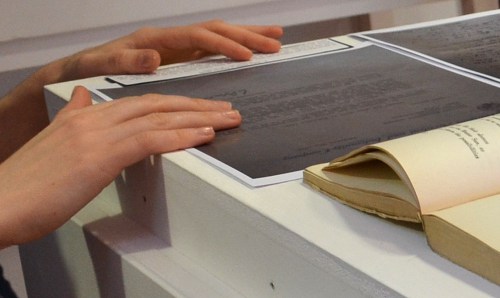Scripting the Globe
An exhibition at the International Anthony Burgess Foundation, 16 - 27 June 2014

In December 2013 we had the opportunity to co-curate the "Scripting the Globe" exhibition with Dr Francesca Billiani and Dr Mila Milani. Our involvement began when we received an e-mail soliciting Museology-based students to collaborate with the Italian Studies department on this project. Four Masters Art Gallery and Museum Studies students volunteered: Krista Goodfellow, Sonia Llewelyn, Michelle Kenner, and Madeleine Witek. Additionally, a Museology PhD student, Chiara Zuanni, joined the team.
"Scripting the Globe" is part of a larger AHRC-funded project, "Mapping Literary Space: Italian Intellectuals, Literary Journals, Publishing Firms 1940-1960" led by Dr Francesca Billiani (The University of Manchester) and Dr Daniela La Penna (University of Reading).
The project aims to showcase the impact and wide network of Italian literary journals following the Second World War. More specifically, it displays for the first time new archival materials demonstrating the relationships between international writers and the editors of the literary journals “Il Politecnico”, “Nuovi Argomenti”, “Lo Spettatore italiano”, and “Botteghe Oscure”. Letters from the likes of Henry Kissinger (then a young graduate student) and Truman Capote illuminate the wide reach of these journals. Not all letters came from household names, though. A young British soldier wrote (in Italian) to the editor of “Il Politecnico”, Elio Vittorini, praising his journal.
Literary intellectual journals offer an exciting insight into this intense period of Italian history, which featured huge societal, politic, and intellectual changes. The world was divided by the Cold War, and yet, as Lienhard Bergel comments, these journals defined themselves as left-winged without the fear of being condemned as Communist, as may have been the situation if the same journals were published in the United States. Probably less controversial but even more fascinating was learning about the life of the founder of "Botteghe Oscure", Marguerite Caetani: a self-made woman from New England, Caetani moved to Paris for her studies and there met and married the Italian Prince Caetani. While in France, she founded and edited the intellectual journal "Commerce". She moved to Italy in the 1930s and in 1948 she founded “Botteghe Oscure”, a literary journal which drew on her vast European and transatlantic network. The journal published short novels and poems in their original languages, whether Spanish, English, German, French or others. It contributed widely to promote foreign writers in Italy and made available the work of many Italian intellectuals abroad.
Curating this exhibition not only allowed us to learn about these impressive networks and gain practical experience, it also prompted us to reflect on our own curatorial practices. During the process, Mila and Francesca curated the academic contents while we were asked to help with design and display issues. This led to multiple discussions and changes in minute details while we attempted to incorporate our initial ideas. Striking a balance between academia and accessibility was sometimes a challenge. As museology students, we attempted to engage the public by humanising the topic and contextualising the research. The exhibition draws on a depth of academic research, and it was a challenge for us to translate this into the display while keeping a detailed account of the topic. The balance between academia and accessibility began with the title: how long should it be? What words should we use? Is it catchy or is it boring? The conversation continued as we prepared the design brief for the main poster, went on while discussing size and fonts of the posters and labels, and informed how much were we going to show and tell about these letters. Sadly, we could not display all the letters, but we had to choose the most relevant and interesting. As museologists we would have liked to be brutal; as academics it was a bit heartbreaking.
Installation day was a typical example of how curating exhibitions of any sort can come with their own surprises. The original layout of the space in which we were to display the letters was altered, and we were unsure about where to hang the original five posters. Ultimately, we had to change our plans and add another poster last minute to fill in neglected wall space. This worked to our advantage, however; we were able to add a map that visually depicts the connections between Italian literary journals and their international contributors. Fortunately, we were able to plan the progression of the exhibition beforehand, so we knew immediately where letters should be displayed. In the end, some things can be predetermined, but exhibition plans are always a work in progress. Flexibility and communication were key to our being able to install the exhibition successfully and cooperatively.
'Scripting the Globe' opened to the public on Monday, 16 June 2014 at the International Anthony Burgess Foundation on Cambridge Street, Manchester.

